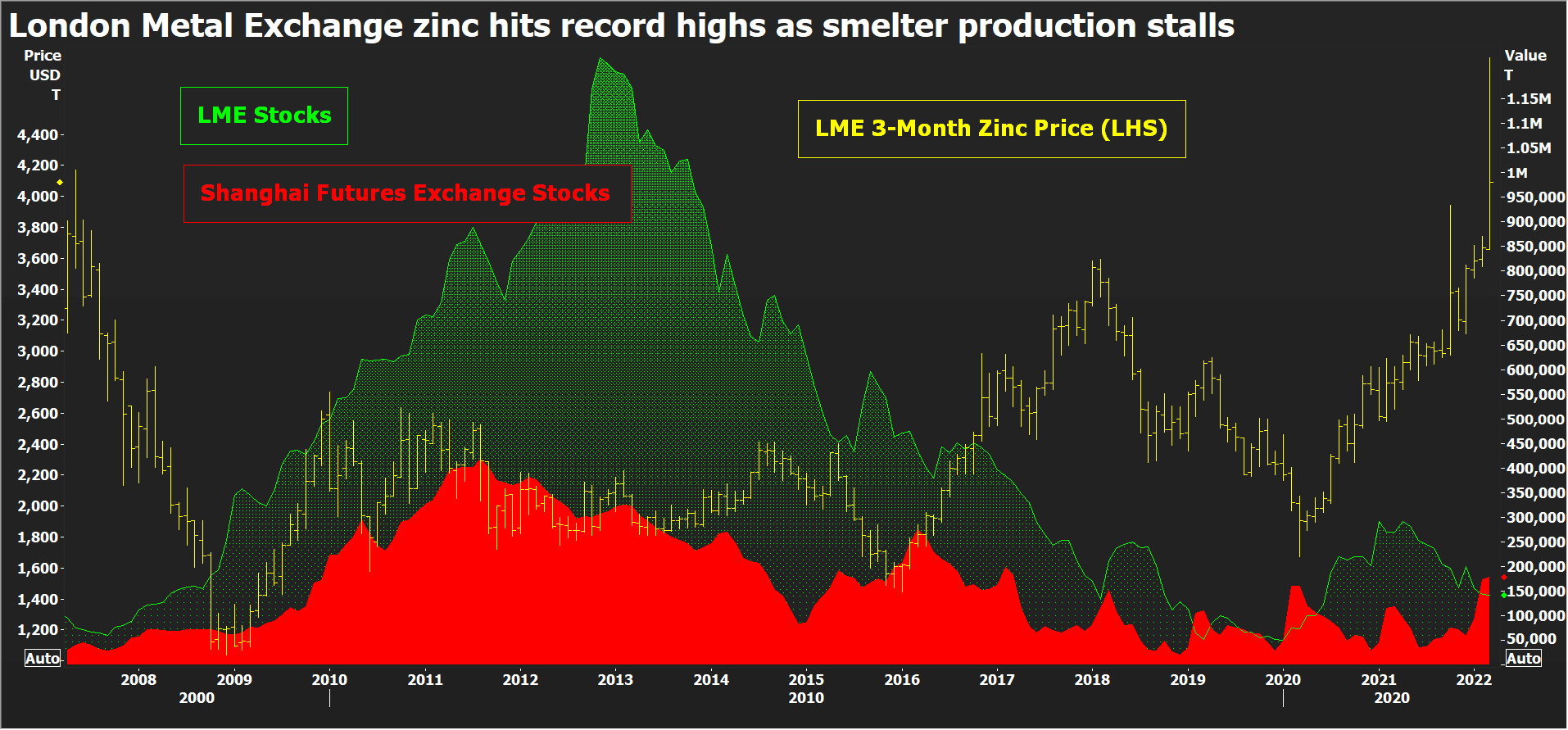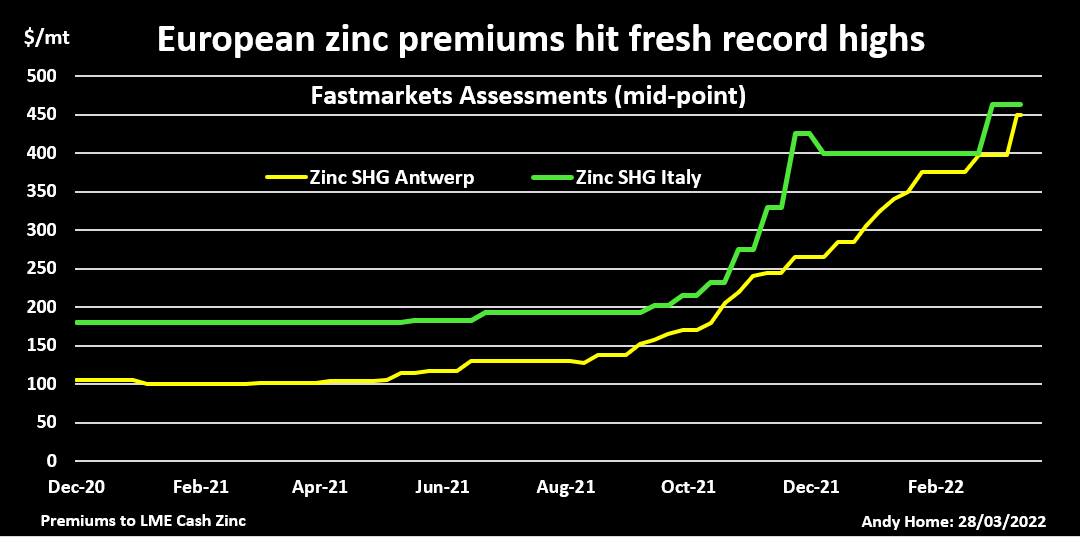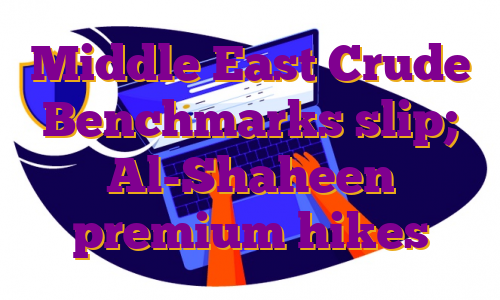LONDON, March 29 (Reuters) – London Metal Exchange (LME) zinc recorded a new all-time high of $4,896 per tonne earlier this month, eclipsing the previous 2006 peak of $4,580 per tonne.True, the March 8 spike was over in a matter of hours and looked very much like the forced close-out of positions to cover margin calls in the LME nickel contract, which was imploding at the time before being suspended.But zinc has since re-established itself above the $4,000 level, last trading at $4,100 per tonne, amid escalating supply chain tensions.Register now for FREE unlimited access to Reuters.comRussia’s invasion of Ukraine, which Moscow calls a special military operation, doesn’t have any direct impact on zinc supply as Russian exports are negligible.But the resulting increase in energy prices is piling more pressure on already struggling European smelters.European buyers are paying record physical premiums over and above record high LME prices, a tangible sign of scarcity which is now starting to spread to the North American market.The world is not yet running out of the galvanising metal but a market that even a few months ago was expected to be in comfortable supply surplus is turning out to be anything but. LME zinc price and stocks, Shanghai stocksEUROPEAN POWER-DOWNOne European smelter – Nyrstar’s Auby plant in France – has returned to partial production after being shuttered in January due to soaring power costs. But run-rates across the company’s three European smelters with combined annual capacity of 720,000 tonnes will continue to be flexed “with anticipated total production cuts of up to 50%”, Nyrstar said.High electricity prices across Europe mean “it is not economically feasible to operate any of our sites at full capacity”, it said.Still on full care and maintenance is Glencore’s (GLEN.L) 100,000-tonne-per-year Portovesme site in Italy, another power-crisis casualty.Zinc smelting is an energy-intensive business and these smelters were already in trouble before Russia’s invasion sent European electricity prices spiralling yet higher.Record-high physical premiums, paid on top of the LME cash price, attest to the regional shortage of metal. The premium for special-high-grade zinc at the Belgian port of Antwerp has risen to $450 per tonne from $170 last October before the winter heating crisis kicked in.The Italian premium has exploded from $215.00 to $462.50 per tonne over the same time frame, according to Fastmarkets.LME warehouses in Europe hold just 500 tonnes of zinc – all of it at the Spanish port of Bilbao and just about all of it bar 25 tonnes cancelled in preparation for physical load-out.Tightness in Europe is rippling over the Atlantic. Fastmarkets has just hiked its assessment of the U.S. Midwest physical premium by 24% to 26-30 cents per lb ($573-$661 per tonne).LME-registered stocks in the United States total a low 25,925 tonnes and available tonnage is lower still at 19,825 tonnes. This time last year New Orleans alone held almost 100,000 tonnes of zinc.
LME zinc price and stocks, Shanghai stocksEUROPEAN POWER-DOWNOne European smelter – Nyrstar’s Auby plant in France – has returned to partial production after being shuttered in January due to soaring power costs. But run-rates across the company’s three European smelters with combined annual capacity of 720,000 tonnes will continue to be flexed “with anticipated total production cuts of up to 50%”, Nyrstar said.High electricity prices across Europe mean “it is not economically feasible to operate any of our sites at full capacity”, it said.Still on full care and maintenance is Glencore’s (GLEN.L) 100,000-tonne-per-year Portovesme site in Italy, another power-crisis casualty.Zinc smelting is an energy-intensive business and these smelters were already in trouble before Russia’s invasion sent European electricity prices spiralling yet higher.Record-high physical premiums, paid on top of the LME cash price, attest to the regional shortage of metal. The premium for special-high-grade zinc at the Belgian port of Antwerp has risen to $450 per tonne from $170 last October before the winter heating crisis kicked in.The Italian premium has exploded from $215.00 to $462.50 per tonne over the same time frame, according to Fastmarkets.LME warehouses in Europe hold just 500 tonnes of zinc – all of it at the Spanish port of Bilbao and just about all of it bar 25 tonnes cancelled in preparation for physical load-out.Tightness in Europe is rippling over the Atlantic. Fastmarkets has just hiked its assessment of the U.S. Midwest physical premium by 24% to 26-30 cents per lb ($573-$661 per tonne).LME-registered stocks in the United States total a low 25,925 tonnes and available tonnage is lower still at 19,825 tonnes. This time last year New Orleans alone held almost 100,000 tonnes of zinc. Fastmarkets Assessments of Antwerp and Italian physical zinc premiumsREBALANCING ACTAbout 80% of the LME’s registered zinc inventory is currently located at Asian locations, first and foremost Singapore, which holds 81,950 tonnes.There is also plenty of metal sitting in Shanghai Futures Exchange warehouses. Registered stocks have seen their usual seasonal Lunar New Year holiday surge, rising from 58,000 tonnes at the start of January to a current 177,826 tonnes.Quite evidently Asian buyers haven’t yet been affected by the unfolding supply crunch in Europe and there is plenty of potential for a wholesale redistribution of stocks from east to west.This is what happened last year in the lead market, China exporting its surplus to help plug gaps in the Western supply chain. Lead, however, should also serve as a warning that global rebalancing can be a slow, protracted affair due to continuing log-jams in the shipping sector.MOVING THE GLOBAL DIALWhile there is undoubted slack in the global zinc market, Europe is still big enough a refined metal producer to move the market dial.The continent accounts for around 16% of global refined output and the loss of production due to the regional energy crisis has upended the zinc market narrative.When the International Lead and Zinc Study Group (ILZSG) last met in October, it forecast a global supply surplus of 217,000 tonnes for 2021.That was already a sharp reduction from its earlier April assessment of a 353,000-tonne production overhang. The Group’s most recent calculation is that the expected surplus turned into a 194,000-tonne shortfall last year. The difference was almost wholly down to lower-than-forecast refined production growth, which came in at just 0.5% compared with an October forecast of 2.5%.With Chinese smelters recovering from their own power problems earlier in the year, the fourth-quarter deceleration was largely due to lower run-rates at Europe’s smelters.The ILZSG’s monthly statistical updates are inevitably a rear-view mirror but Europe’s production losses have continued unabated over the first quarter of 2022.Moreover, the scale of the shift higher in power pricing, not just spot but along the length of the forward curve, poses a longer-term question mark over the viability of European zinc production.A redistribution of global stocks westwards can provide some medium-term relief but zinc supply is facing a new structural challenge which is not going away any time soon.The opinions expressed here are those of the author, a columnist for Reuters.Register now for FREE unlimited access to Reuters.comEditing by David ClarkeOur Standards: The Thomson Reuters Trust Principles.Opinions expressed are those of the author. They do not reflect the views of Reuters News, which, under the Trust Principles, is committed to integrity, independence, and freedom from bias. .
Fastmarkets Assessments of Antwerp and Italian physical zinc premiumsREBALANCING ACTAbout 80% of the LME’s registered zinc inventory is currently located at Asian locations, first and foremost Singapore, which holds 81,950 tonnes.There is also plenty of metal sitting in Shanghai Futures Exchange warehouses. Registered stocks have seen their usual seasonal Lunar New Year holiday surge, rising from 58,000 tonnes at the start of January to a current 177,826 tonnes.Quite evidently Asian buyers haven’t yet been affected by the unfolding supply crunch in Europe and there is plenty of potential for a wholesale redistribution of stocks from east to west.This is what happened last year in the lead market, China exporting its surplus to help plug gaps in the Western supply chain. Lead, however, should also serve as a warning that global rebalancing can be a slow, protracted affair due to continuing log-jams in the shipping sector.MOVING THE GLOBAL DIALWhile there is undoubted slack in the global zinc market, Europe is still big enough a refined metal producer to move the market dial.The continent accounts for around 16% of global refined output and the loss of production due to the regional energy crisis has upended the zinc market narrative.When the International Lead and Zinc Study Group (ILZSG) last met in October, it forecast a global supply surplus of 217,000 tonnes for 2021.That was already a sharp reduction from its earlier April assessment of a 353,000-tonne production overhang. The Group’s most recent calculation is that the expected surplus turned into a 194,000-tonne shortfall last year. The difference was almost wholly down to lower-than-forecast refined production growth, which came in at just 0.5% compared with an October forecast of 2.5%.With Chinese smelters recovering from their own power problems earlier in the year, the fourth-quarter deceleration was largely due to lower run-rates at Europe’s smelters.The ILZSG’s monthly statistical updates are inevitably a rear-view mirror but Europe’s production losses have continued unabated over the first quarter of 2022.Moreover, the scale of the shift higher in power pricing, not just spot but along the length of the forward curve, poses a longer-term question mark over the viability of European zinc production.A redistribution of global stocks westwards can provide some medium-term relief but zinc supply is facing a new structural challenge which is not going away any time soon.The opinions expressed here are those of the author, a columnist for Reuters.Register now for FREE unlimited access to Reuters.comEditing by David ClarkeOur Standards: The Thomson Reuters Trust Principles.Opinions expressed are those of the author. They do not reflect the views of Reuters News, which, under the Trust Principles, is committed to integrity, independence, and freedom from bias. .
Sycamore can relieve Ted Baker from its misery
The Ted Baker logo is seen in Central Valley, New York, U.S., February 15, 2022. REUTERS/Andrew KellyRegister now for FREE unlimited access to Reuters.comMILAN, March 18 (Reuters Breakingviews) – Sycamore Partners is digging in the fashion discount corner. The U.S. fund, which specialises in struggling retail assets, said on Friday that it could make a cash offer for hard-pressed British fashion firm Ted Baker (TED.L), triggering a 19% rally in its stock. For investors, the approach is a way of escaping the clutches of founder and former Chief Executive Ray Kelvin, whose overenthusiastic hugging habits led to his resignation in 2019 and a share price rout. Ted Baker shares are worth less than a tenth of their value before the scandal erupted.For Sycamore, it looks like an easy win. Assuming the U.S. fund pays 230 million pounds, a roughly 30% premium to Thursday’s market value, it could make a chunky 30% internal rate of return by simply growing revenue at 5% a year for five years and hiking the EBITDA margin to 12%, Breakingviews calculations show. That suggests the retailer may be worth more. Despite uncertainties in Europe because of the Ukrainian conflict, Ted Baker has worked hard to reduce its discounted sales to protect margins. Sycamore has ample wiggle room to pull investors from their misery. (By Lisa Jucca)Follow @Breakingviews on TwitterRegister now for FREE unlimited access to Reuters.comCapital Calls – More concise insights on global finance:Tencent WeChat Pay rejig would have 1 bln problems read more KKR property deal threads the needle in Japan read more Electric-car makers need to stay on their diet read more Online grocer woes imply fresh price wars read more China Swiss IPOs as predictable as a cuckoo clock read more Register now for FREE unlimited access to Reuters.comEditing by Ed Cropley and Oliver TaslicSign up for a free trial of our full service at https://www.breakingviews.com/trial and follow us on Twitter @Breakingviews and at www.breakingviews.com. All opinions expressed are those of the authors. .
Middle East Crude Benchmarks slip; Al-Shaheen premium hikes
BEIJING, March 11 (Reuters) – Middle East crude benchmarks Oman, Dubai and Murban shaded weaker on Friday as major oil producers strive to bring more supply to the market to offset the embargos on Russian cargos, while policymakers around the globe mull tapering inflation.Qatar Energy has sold four May-loading crude cargoes via tenders at record premiums after buyers avoided Russian oil amid fears of Western sanctions following Moscow’s invasion of Ukraine. Spot premiums for al-Shaheen crude nearly tripled from the previous month after the producer sold two al-Shaheen crude cargoes to Unipec and PetroChina at about $12 a barrel above Dubai quotes, they said. The cargoes will load on May 2-3 and 29-30.Register now for FREE unlimited access to Reuters.comExports of Malaysia’s flagship Kimanis crude oil are set to fall to six cargoes in May, down two from April, due to maintenance at oilfields offshore Sabah, a preliminary loading schedule showed on Friday. read more Sinopec’s (600028.SS) 250,000 barrels-per-day Yangzi refinery will shut down its whole plant for a 61-day planned maintenance, starting from March 15, according to a company statement. OSPKuwait raised the official selling prices (OSPs) for two crude grades it sells to Asia in April from the previous month, a price document reviewed by Reuters showed on Friday. read more The producer has set April Kuwait Export Crude (KEC) price at $4.80 a barrel above the average of Oman/Dubai quotes, up $2.25 from the previous month.It also raised the April Kuwait Super Light Crude (KSLC) OSP to $5.95 a barrel above Oman/Dubai quotes, up $2.60.The price hike for KEC was 10 cents more than that for Saudi’s Arab Medium crude in the same month.WINDOWCash Dubai’s premium to swaps fell 61 cents to $11.48 a barrel.PRICES ($/BBL)India’s ONGC Videsh failed to get bids in its tender to sell 700,000 barrels of Russian Sokol crude in a growing backlash against Moscow for its invasion of Ukraine, sources familiar with the matter said. read more This was the first tender by ONGC Videsh, since the war in Ukraine began on Feb. 24.NEWSNorwegian state oil company Equinor (EQNR.OL) has stopped trading Russian oil as it winds down operations there in the wake of Moscow’s invasion of Ukraine. read more Canada is studying ways to increase pipeline utilization to boost crude exports as Europe seeks to reduce its dependence on Russian oil. read more European Union leaders are set to agree on Thursday to cut their reliance on Russian fossil fuels, although they are divided over whether to cap gas prices and to sanction oil imports as Moscow wages war in Ukraine. read more The European Central Bank will stop pumping money into financial markets this summer, it said on Thursday, paving the way for an increase in interest rates as soaring inflation outweighs concerns about the fallout from Russia’s invasion of Ukraine. read more For crude prices, oil product cracks and refining margins, please click on the RICs below.Register now for FREE unlimited access to Reuters.comReporting by Muyu Xu and Florence Tan; Editing by Krishna Chandra EluriOur Standards: The Thomson Reuters Trust Principles. .
Asia Fuel Oil VLSFO cash premiums gain, HSFO cash premiums hit multi-month highs
SINGAPORE, March 8 (Reuters) – Asia’s cash premiums for 0.5% very low-sulphur fuel oil (VLSFO) rose for a second consecutive session on Tuesday, while the prompt-month spread for the marine fuel grade remained in steep backwardation.Cash differentials for Asia’s 0.5% VLSFO , which have surged about 44% in the last month, were at a premium of $19.80 a tonne to Singapore quotes, compared with $19.67 per tonne a day earlier.The March/April VLSFO time spread traded at $32 a tonne on Tuesday, compared with $33.75 a tonne on Monday.Register now for FREE unlimited access to Reuters.comThe front-month VLSFO crack rose to $29.83 per barrel against Dubai crude during Asian trading hours, up from $29.61 per barrel in the previous session.Meanwhile, the 380-cst HSFO barge crack for April traded at a discount of $16.79 barrel to Brent on Tuesday, while cash premiums for 380-cst high sulphur fuel oil (HSFO) rose to a more than four-month high of $5.55 per tonne to Singapore quotes.Backed by firmer deals in the physical market, the cash differentials for 180-cst HSFO surged to a premium of $8.59 a tonne to Singapore quotes, a level not seen since October last year. They were at a premium of $6.39 per tonne a day earlier.ASIA REFINERS TO CRANK UP RUNS- Some Asian refineries plan to increase output in May to cash in on high prices for gasoil exports to Europe, even as the steepest crude prices in 14 years threaten profit margins, numerous trade sources said. read more – European diesel supplies have shrunk following the disruption of western sanctions imposed on Russia in response to its invasion of Ukraine, which it describes as a “special operation”.- Strong European demand has boosted Asian refiners’ profits for producing gasoil for exports to the West. However, the refiners are also paying record premiums for Middle East crude supplies after the disruption of sanctions left buyers with limited options.WINDOW TRADES- One 380-cst high-sulphur fuel oil (HSFO) deal, two 180-cst HSFO trades- One VLSFO trade was reportedOTHER NEWS- The United States is willing to move ahead with a ban on Russian oil imports without the participation of allies in Europe, two people familiar with the matter told Reuters, in light of Russia’s invasion of Ukraine. read more – Oil prices rose on Tuesday, with Brent surging past $126 a barrel, as fears of formal sanctions against Russian oil and fuel exports spurred concerns about supply availability.ASSESSMENTSRegister now for FREE unlimited access to Reuters.comReporting by Koustav Samanta; Editing by Shinjini GanguliOur Standards: The Thomson Reuters Trust Principles. .
Brookfield flips AGL out of furnace into coal fire
MELBOURNE, March 7 (Reuters Breakingviews) – The Canadian fund manager and its tech billionaire partner are abandoning a green takeover plan after their sweetened $6 bln bid was rejected. It leaves the Aussie power producer grappling with a weak demerger proposal and a pushy investor. Boss Graeme Hunt will feel the heat.Full view will be published shortly.Follow @AntonyMCurrie on TwitterRegister now for FREE unlimited access to Reuters.comCONTEXT NEWS- Brookfield Asset Management and Atlassian co-Chief Executive Mike Cannon-Brookes are walking away from an A$8.3 billion ($6.1 billion) takeover proposal for Australian power company AGL Energy, according to a March 6 tweet by Cannon-Brookes.- The consortium “looking to take private & transform AGL is putting our pens down – with great sadness,” he tweeted.- The decision follows AGL’s board rejection of a sweetened offer at A$8.25 a share, a 10% increase from the original offer.- The revised entreaty valued AGL’s equity at just under A$5.5 billion, a 15% premium to the price on Feb. 18, the day before the Brookfield group made its first offer, and a 31% premium to the three-month volume-weighted average price. Including debt, the offer valued the AGL enterprise at nearly A$8.3 billion.Register now for FREE unlimited access to Reuters.comEditing by Jeffrey Goldfarb and Thomas ShumOur Standards: The Thomson Reuters Trust Principles.Opinions expressed are those of the author. They do not reflect the views of Reuters News, which, under the Trust Principles, is committed to integrity, independence, and freedom from bias. .






